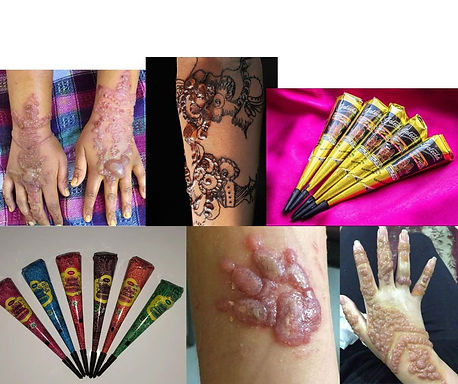Here at Pure Henna we handmake our paste using
100% Organic natural Henna powder.
Pure Henna does not use or encourage the use of any chemically enhanced henna paste.
!Warning!
Graphic images of chemical burns ahead
What Is Black Henna?

Chemically altered henna or "Black Henna" is a made from with PPD (Para-phenylene-diamine) based black hair dye. Although all chemical henna doesn't have to be black to be dangerously chemically altered. Here we will discuss the dangers of chemical henna & ways to spot it and hopefully avoid it in the future.
History Of Chemical Henna
In the 1990s, henna artists in Africa, India, Bali, the Arabian Peninsula and the West began to experiment with PPD (Para-phenylene-diamine) based black hair dye, applying it as a thick paste as they would apply henna in an effort to find something that would quickly make jet black temporary body art. PPD can cause severe allergic reactions with blistering, intense itching, permanent scarring and permanent chemical sensitivities. Henna does not cause these injuries. Henna made with PPD can cause lifelong sensitization to coal tar derivatives and blackhenna made with gasoline, kerosene, lighter fluid, paint thinner, and benzene has been linked to adult leukemia.
What are the health consequences of chemical Henna?
The most frequent serious health consequence of having a black henna temporary tattoo is sensitization to hair dye and related chemicals. If a person has had a black henna tattoo and later dyes their hair with chemical hair dye, the allergic reaction may be life-threatening and require hospitalization. Because of the epidemic of PPD allergic reactions, chemical hair dye products now post warnings on the labels: “Temporary black henna tattoos may increase your risk of allergy.” Do not colour your hair if – you have experienced a reaction to a temporary black henna tattoo in the past.
PPD sensitivity is lifelong. A person who has become sensitized through black henna tattoos may have future allergic reactions to perfumes, printer ink, chemical hair dyes, textile dye, photographic developer, sunscreen and some medications. Anyone who has an itching and blistering reaction to a black body stain should go to a doctor, and report that they have had an application of PPD to their skin.

How long until you get a reaction?
PPD black henna use is widespread, particularly in tourist areas. Because the blistering reaction appears 3 to 12 days after the application, most tourists have left and do not return to show how much damage the artist has done. This permits the artists to continue injuring others, unaware they are causing severe injuries. The high profit margins of black henna (it being cheaper than natural Henna) and the demand for body art that emulates “tribal tattoos” further encourage artists to deny the dangers.
_edited.jpg)
How to tell the difference
It is not difficult to recognise and avoid PPD black henna:
-
if a paste stains skin on the torso black in less than ½ hour, it probably has PPD in it.
-
if the paste is mixed with peroxide, or if peroxide is wiped over the design to bring out the colour, it probably has PPD in it.
-
Pre packaged cones/imported cones- probably have PPD’s – (synthetic cold tar dye- carcinogenic )
-
Plant based real Henna once mixed has a very short shelf life. Any henna which doesn’t need to be kept frozen must contain additional ingredients such as preservatives or chemical dyes.
There are literally hundreds of chemically-adulterated ‘henna‘ products, and most of them say they are 100% natural.

Research
Doing your own research is the best way to gain an understanding on what to look out for. Simply search "Black Henna" in google and you will be met with hundreds of pages of information. Be Warned! maybe skip over the pictures of you have a weak stomach.